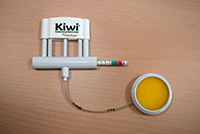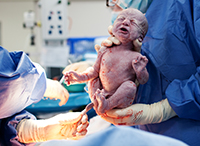There are a number of ways that labouring women can be assisted to birth their babies. The method chosen depends on the stage of labour, the reason for assistance, the wellbeing of mother and baby, and the urgency of the situation. These different methods are collectively called assisted, instrumental or operative birthing options. These methods include: forceps and Ventouse extractor vaginal births and emergency caesarean birth.
Labour and Birth
Assisted/instrumental or operative birthing
Assisted/instrumental or operative birthing
We discussed the ways in which a normal labour and birth can be achieved in the active birthing section. Some of these ways included, maintaining an upright position, having good support in labour, effectively managing pain, maintaining good hydration and nutrition, using different positions in labour and waiting a little longer prior to pushing if you have an epidural. Nonetheless, sometimes circumstances beyond our control can occur out of the blue that require additional assistance. When these things occur, the Maternity Team can offer a range of alternative options to help you birth your baby safely and in a timely manner.
About 1 in 10 women in Australia will need an assisted vaginal birth, using instruments such as forceps or the Ventouse extractor (these instruments are discussed in more detail below). These can only be used in the second stage (pushing stage) of labour because the cervix must be fully dilated and the baby’s head must be engaged in the birth canal for assisted vaginal birth to be achieved safely. Your obstetrician will discuss with you and/or your birth partner the reasons why they are recommending an assisted birth. Depending on the reason, you may or may not be able to push during assisted birthing. Some of the more common reasons you might need assistance using forceps or Ventouse birth include:
- Your baby is not moving out of the birth canal as would normally be expected. For example, you have been pushing and the baby’s head does not advance. Perhaps you are exhausted or the baby’s head is in a position that makes pushing difficult (e.g. malposition, such as posterior or transverse).
- There are concerns about your baby's wellbeing during birth or there are signs of fetal compromise. For example, the baby’s heart rate has slowed.
- You are unable to, or have been advised not to, push during birth. For example, you have pre-eclampsia or high blood pressure where these conditions will worsen with pushing; or where the baby is being birthed by the breech and forceps are used to gently guide the head out once the body has been birthed.
Forceps
Obstetric forceps are smooth metal instruments that look like large tongs or spoons. They comprise two opposing sides that fit together. The curved ends fit snuggly around the baby’s head, cradling it during birthing. The other ends fit together forming a handle for the obstetrician to pull and guide the baby’s head out during a contraction. Pain relief in the form of a local anaesthetic or epidural is provided. The forceps are applied in between contractions during the second stage. Your obstetrician will advise you whether they require you to push with a contraction or not. It is common to have an episiotomy performed at this time when the forceps are guiding the baby’s head out. It may take more than one contraction to birth the baby’s head. Once the baby’s head is born, the forceps are carefully removed and the baby’s body is birthed as usual. Forceps are also used to guide a breech baby’s head out and are sometimes used during caesarean birth.
Ventouse extractor

These days the Ventouse (commonly called the vacuum extractor) extractor is more commonly used than forceps. The vacuum cup is made of soft plastic. The larger end of the plastic cup is inserted into the vagina and placed onto the baby’s head. The other end is attached to suction tubing externally. Suction is then created against the baby’s head allowing the obstetrician to gently pull the baby out. It may cause a raised swelling on the baby’s head, but this soon fades, usually within a day. You may or may not be required to push and you may or may not need an episiotomy, depending on your individual circumstances and the reason for the vacuum assisted vaginal birth.
Your obstetrician and/or midwife will discuss with you and your birth partner, your labour progress, you and your baby’s wellbeing during labour and the reason for recommending an assisted vaginal birth. These are some of the things you can expect if you decide to have an assisted vaginal birth:
- Abdominal and vaginal examinations by your obstetrician to determine the baby’s position in the birth canal and whether assisted vaginal birth is possible
- Continuous fetal monitoring of the baby’s heart rate (and your vital signs as indicated) throughout the procedure
- Verbal informed consent discussion and/or written consent. Sometimes if it is anticipated that a caesarean birth will eventuate, a written consent is obtained in addition to the verbal informed consent discussion
- Bladder emptying. It is usual for the obstetrician or midwife to pass a urinary catheter (thin rubber tube) into your bladder to empty it
- Pain relief. If you do not already have an effective epidural in place, you will be given a local anaesthetic injection into the area of the vagina and perineum
- Your obstetrician will decide whether forceps or Ventouse is the most appropriate method for assisted vaginal birth
- Your midwife and obstetrician will support and guide you on whether and when to push during the assisted birth
- A Paediatrician and/or Neonatal Team members may be called to receive and assist the baby at birth depending on you and your baby’s wellbeing, your individual circumstances and the reason for the assisted birth
Emergency (unplanned) caesarean birth

Sometimes women may need assistance to birth their babies by operative means (emergency or unplanned caesarean birth), that is, through an incision (surgical cut) into the mother’s abdomen and uterus. Unplanned caesarean births usually result from emergent situations where it becomes impossible or undesirable to birth the baby vaginally. Approximately 1 in 3 births in Australia are caesarean births and up to half of these are performed for emergency reasons.
An emergency caesarean birth may be performed at any time during the first or second stage of labour, depending on the circumstances. In these circumstances, it is safer for the mother and/or baby to have an emergency caesarean birth than to continue to try for a vaginal birth. Your obstetrician will discuss the reason why an unplanned or emergency caesarean birth is recommended for you and your baby. Some of the more common reasons to birth the baby by emergency caesarean during first or second stage include:
- Cord prolapse in the first stage of labour or where forceps or Ventouse birth are not immediately possible in second stage
- Signs of fetal compromise (indicated by the baby’s heart rate pattern, presence of meconium and/or fetal blood sampling tests)
- Delay in the progress of labour caused by a misfit between the baby and the mother’s pelvis
- Premature labour and birth where caesarean birth is deemed to be safer for the baby or babies
- Emergent conditions in the mother arising in labour such as sudden bleeding, pre-eclampsia or other medical or obstetric complications discussed earlier
- Failed induction of labour, failed trial of labour, failed forceps or Ventouse birth
A caesarean section is a major surgical operation in which your baby is born through a cut into your abdomen and uterus. The cut in your abdomen is usually made across the bikini line (this is often called a lower uterine segment caesarean section). It is usually performed under spinal or epidural anaesthesia but sometimes it is necessary for the Anaesthetist to put you to sleep with a general anaesthetic.
- You may be given oxygen as the Maternity Team prepares you for caesarean. You will have an IV infusion and a urinary catheter in place. These are usually removed within 24 hours unless indicated otherwise
- You may be in the operating theatre for more than one hour, but the baby is usually born within minutes
- Unless you are having a general anaesthetic, in most cases, your birth partner can be with you. If they can’t be with you, they will be shown where to wait and will usually see the baby soon after birth
- At birth your baby will be received by the Neonatal Team. She/he will be warmed and dried off and carefully examined and resuscitated if necessary
- Your midwife will stay and look after you and your baby in the theatre and the recovery area before taking you both to the postnatal ward
- The midwife in the postnatal ward will care for you and help you with breastfeeding
- If your baby requires special care or monitoring the Neonatal Team will transfer them to the Intensive or Special Care Nurseries. You and/or your birth partner can usually go to see your baby there soon after birth depending on you and your baby’s condition.
For more information
Further information about caesareans can be found in the section Elective/planned caesarean births.

